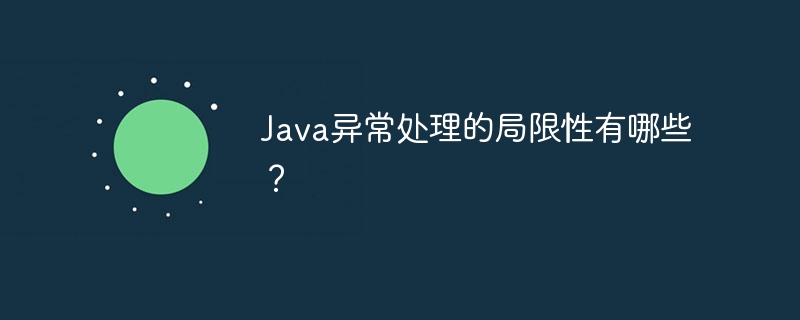
Limitations of Java exception handling include: inability to catch virtual machine and operating system exceptions. Exception handling can mask deeper problems. Nested exceptions are difficult to debug. Exception handling code reduces readability. Runtime checked exceptions have a performance overhead.

Limitations of Java exception handling
Although Java exception handling mechanism is very powerful, it also has some inherent limitations. :
1. Unable to catch all exceptions
Some exceptions cannot be caught and handled by Java, for example:
2. Exception handling may mask deeper problems
Exception handling may prevent code execution or produce incorrect output, but it will not solve it underlying issues. For example, if a database connection fails, handling the exception may prevent the application from crashing, but it will not solve the problem that caused the connection to fail.
3. Difficulty debugging nested exceptions
Exceptions can be nested within other exceptions, making debugging a challenge. For example, if a SQL statement throws a SQLException, that exception may be nested within another SQLException, indicating a connection problem. Debugging nested exceptions requires a deep understanding of exception chains.
4. Exception handling code will reduce readability
Using try-catch blocks to handle exceptions will make the code verbose and difficult to read. Especially when there are multiple nested try-catch blocks, it can be difficult to track the flow of exceptions.
5. Exception handling performance overhead
Checking exceptions at runtime will incur performance overhead. For code that throws exceptions frequently, this can cause performance issues.
Practical Case
Let us consider a simple Java program that attempts to read data from a database. If the database is unavailable or the connection fails, the program throws java.sql.SQLException.
import java.sql.Connection;
import java.sql.DriverManager;
import java.sql.SQLException;
public class DatabaseRead {
public static void main(String[] args) {
try {
// 建立数据库连接
Connection conn = DriverManager.getConnection("jdbc:mysql://localhost:3306/test", "username", "password");
// 执行查询
// ...
} catch (SQLException e) {
// 处理连接或查询错误
e.printStackTrace();
} finally {
// 关闭数据库连接
conn.close();
}
}
}In this example, use a try-catch block to handle database connection or query errors. However, if the database is unavailable or the connection fails, the program will simply terminate without providing information about the underlying problem. Additionally, exception handling code can make the main method lengthy and difficult to read.
The above is the detailed content of What are the limitations of Java exception handling?. For more information, please follow other related articles on the PHP Chinese website!
